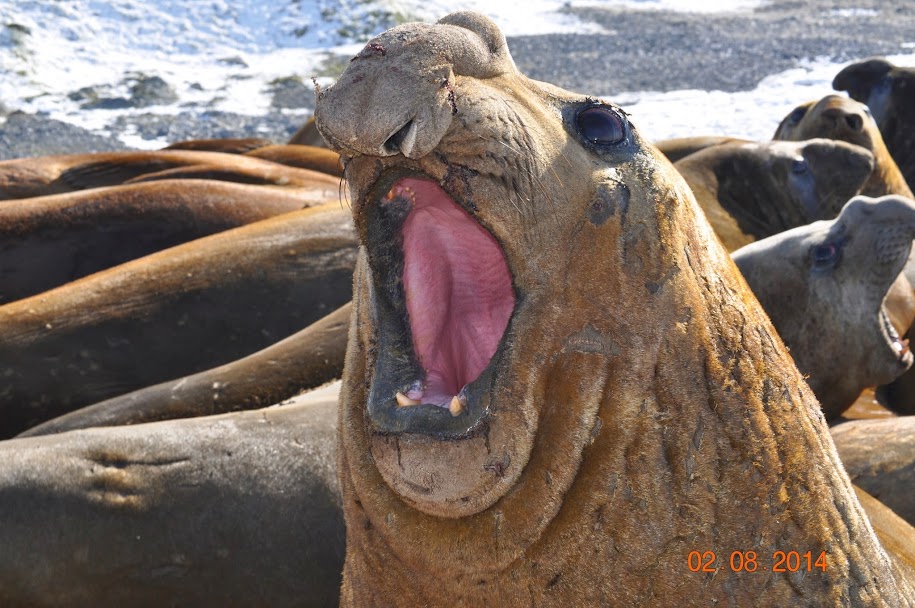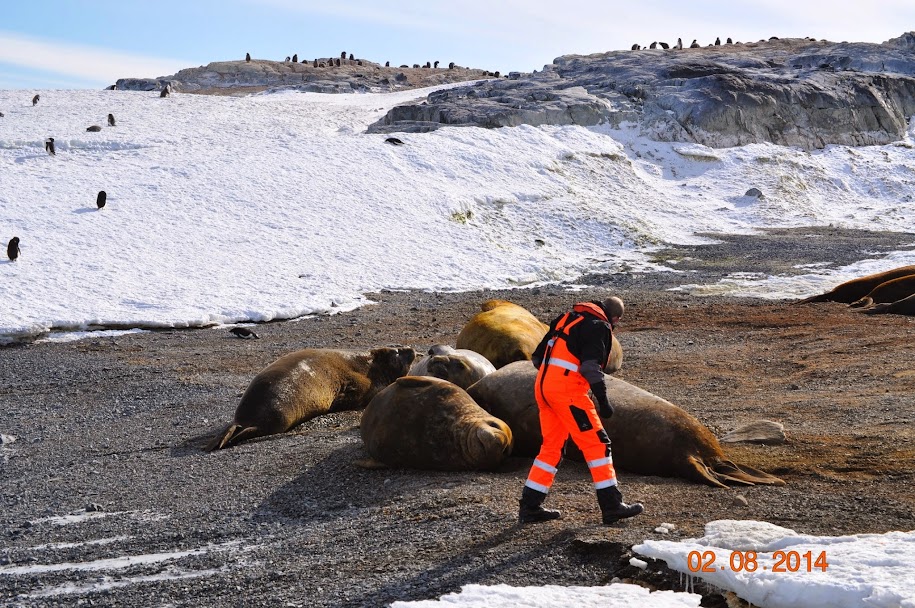As a chemical oceanographer, if I think about seals for scientific purposes, I’m usually thinking about them once they have been “remineralized” back to their component elements: carbon, nitrogen, phosphorous, oxygen (and from the smell of them, sulfur as well). Today, though, was an entirely different encounter – with organisms that biological oceanographers have taken to calling charismatic macrofauna, because they’re usually cute (from a distance), occasionally fuzzy, and they have big dark eyes that make you want to give them a hug. Polar bears, orca whales, all manner of penguins, Weddell seals – they fall into this category. After today, I have to grudgingly admit that elephant seals also fit the description. Despite their smell, they really are impressive, and they have the endearing tendency of piling on top of each other in a snorting, snoozing mass. By our count, this mass was close to 15 metric tons. This number was based on our count of 17 seals, the majority of which were males, weighing close to 1.5 tons each.
Their size and generally lazy aspect belies a mysterious animal that dives close to 1000 m deep and typically forages so far from where biologists find them that it is often difficult to know anything about what they eat. As our seal experts aboard put it, the only thing that we find in their stomachs are squid beaks, so we know they eat those, but the rest is a question mark. This tendency, to swim far and dive deep, has drawn the attention of oceanographers who are always looking for a “vessel of opportunity” to which we can attach a sensor and collect free data, in a manner of speaking. Oceanographers put acoustic sensors on ferries, attach weather instruments and surface seawater instruments to cargo ships, and throw profiling floats into the water from any vessel that makes a passage. But, by far, the most intriguing vessel of opportunity is the elephant seal, which has provided 21,000 depth profiles of temperature and salinity in regions of the ocean, where oceanographers have a hard time reaching – along the ice infested coasts of the southern and arctic oceans where access is limited to the midsummer months and expeditions are routinely thwarted by the difficult working conditions.
 Weddell Seal with newly acquired seal tag. |
 “That’s close enough, back it up!”. |
 Inspecting the pile of ele seals, looking for those who have already molted. |
 Elephant seal with tag on Edward Island. |
With this unique access in mind, we embarked with two biologists from the University of St. Andrews in Scotland, who have pioneered the use of miniature salinity-temperature-depth recorders that can relay their data via Argo satellite, every time the seal hauls out of the water itself for a sunbath, like the ones we found today. The process of tagging is relatively simple. Quick dry epoxy is used to attach the tag near the crown of the seal’s head. Seals molt skin and fur on an annual basis, so the tag will be shed in the next season’s molt. If all holds, then the seal will provide a years worth of data. For everyone’s comfort and safety, the seal is tranquilized with a sedative that wears off completely in about 4 hours. The biggest difficulty, then is the struggle involved with measuring seal dimensions. To get the tape measure underneath a 1.5 ton, thoroughly relaxed seal, involves lots of heaving to roll first one way and then the other. Yesterday, the largest seal measured 4.5 meters in length and 2.9 meters in diameter. Impressive!
The other entertainment of the day was proffered by the large number of Adele penguins sharing the island with the seals. This dry ground was evidently a rookery for the Adeles and we encountered an amazing number of Adele chicks that were almost as big as their parents, but covered in grey down as opposed to the sleek coat that the adults have. The Adele chicks are incessant about their desire to eat and they chase the adults continually around the island begging for food. At some point, when the parents are fed up, they fling themselves into the water just to get away. Occasionally, an Adele chick would jump too, but they evidently found the water shockingly unpleasant, because they would turn around and race back to land, looking and acting as if they’d just been betrayed by their. Dry land that is not snow covered is at a premium along the Antarctic Coast. This was the case with the Edward Islands, a prime spot for all the wildlife that happened upon it. I would’ve enjoyed spending the rest of the cruise there, hanging out with the penguins and snoozing with the seals.







